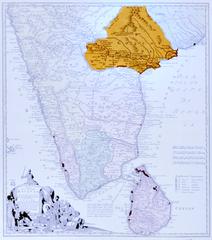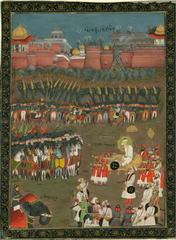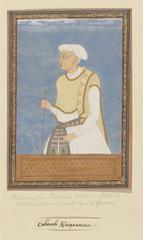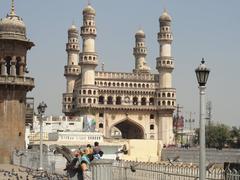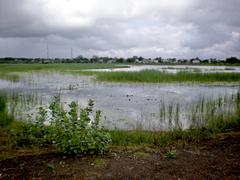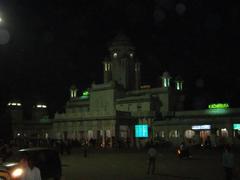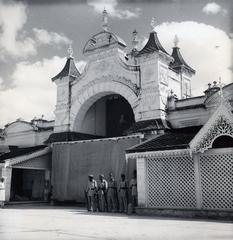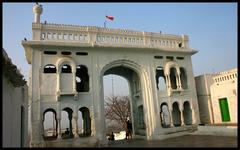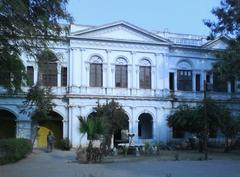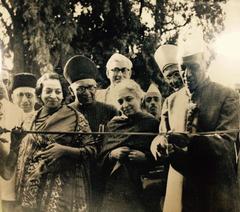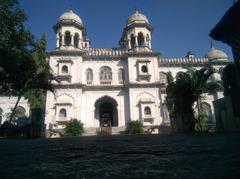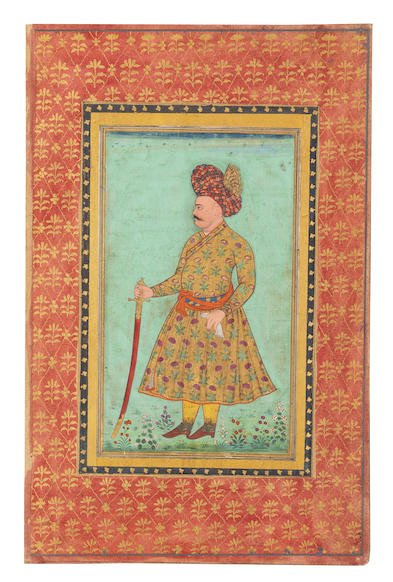
Golconda Fort Visiting Hours, Tickets, and Historical Sites in Secunderabad
Publication Date: 23/07/2024
Why Visit Golconda Fort - An Introduction
Golconda Fort, a historic marvel in the western part of Hyderabad, Telangana, India, is a testament to the region’s rich history and architectural brilliance. Originally a mud fort under the Kakatiya dynasty in the 12th century, it underwent significant transformations under the Bahmani Sultanate and later the Qutb Shahi dynasty from the 14th to the 17th centuries. These transformations, particularly under Sultan Quli Qutb-ul-Mulk, saw the fort evolve into a massive granite structure featuring a blend of Persian, Turkish, and Indian architectural styles (Golconda Fort - Visiting Hours, Tickets, and Historical Insights). The fort’s advanced acoustic design, ingenious water supply system, and historical significance as a hub of the thriving diamond trade make it a must-visit destination for history buffs and architecture enthusiasts alike.
The complex, sprawling over 11 kilometers, includes four distinct forts, eight gateways, and a plethora of royal apartments, halls, temples, mosques, and stables. One of its most fascinating features is the acoustic system, where a clap at the entrance gate can be heard clearly at the highest point, the Bala Hissar pavilion, located about a kilometer away (Golconda Fort - Visiting Hours, Tickets, and Historical Significance). This design was used as a warning system to alert the royals of impending attacks. Moreover, the fort’s strategic location on a granite hill and robust construction made it nearly impregnable, with walls 15 to 18 feet thick built to withstand cannon fire (Essential Visitor Tips for Exploring Golconda Fort in Hyderabad).
In addition to its military and architectural significance, Golconda Fort was the center of a bustling diamond trade, with the region being renowned for producing some of the world’s most famous diamonds, including the Koh-i-Noor and the Hope Diamond (Golconda Fort - Visiting Hours, Tickets, and Historical Insights). Today, Golconda Fort stands as a protected monument under the Archaeological Survey of India, attracting thousands of visitors who come to explore its rich history and cultural heritage (Essential Visitor Tips for Exploring Golconda Fort in Hyderabad).
Table of Contents
- Introduction
- Early Beginnings and Kakatiya Dynasty
- Bahmani Sultanate and the Qutb Shahi Dynasty
- Architectural Marvels
- The Fort’s Strategic Importance
- The Diamond Trade
- Mughal Conquest
- Post-Mughal Era
- Preservation and Tourism
- Visitor Information
- Travel Tips
- Nearby Attractions
- Accessibility
- FAQ
- Cultural Significance
- Visit and Stay Up to Date
- Conclusion
Golconda Fort - Visiting Hours, Tickets, and Historical Insights
Early Beginnings and Kakatiya Dynasty
Golconda Fort, located in the western part of Hyderabad, Telangana, India, has a rich history that dates back to the 12th century. Initially, it was a mud fort under the reign of the Kakatiya dynasty. The Kakatiyas, who ruled over the Deccan Plateau, were known for their architectural prowess and strategic military fortifications. The fort was constructed on a granite hill that stands about 120 meters high, providing a natural defense mechanism against invaders.
Bahmani Sultanate and the Qutb Shahi Dynasty
In the 14th century, the fort came under the control of the Bahmani Sultanate. However, it was during the reign of the Qutb Shahi dynasty (1518-1687) that Golconda Fort saw significant expansion and fortification. Sultan Quli Qutb-ul-Mulk, the founder of the Qutb Shahi dynasty, transformed the mud fort into a massive granite structure. The fort’s architecture during this period was a blend of Persian, Turkish, and Indian styles, reflecting the diverse influences on the Qutb Shahi rulers.
Architectural Marvels
Golconda Fort is renowned for its architectural brilliance. The fort complex is spread over an area of 11 kilometers and includes four distinct forts, eight gateways, and numerous royal apartments, halls, temples, mosques, and stables. One of the most remarkable features is the acoustic system. The fort was designed so that a clap at the entrance gate, the Fateh Darwaza, could be heard clearly at the Bala Hissar pavilion, the highest point of the fort, located about a kilometer away. This ingenious design was used as a warning system to alert the royals in case of an attack.
The Fort’s Strategic Importance
Golconda Fort was not just an architectural marvel but also a significant military stronghold. Its strategic location and robust construction made it nearly impregnable. The fort’s walls, which are 15 to 18 feet thick, were built to withstand cannon fire. Additionally, the fort had a complex water supply system that ensured a steady supply of water even during sieges. This system included Persian wheel-driven wells, aqueducts, and storage tanks.
The Diamond Trade
Golconda Fort was also the center of a flourishing diamond trade. The region around Golconda was rich in diamond mines, including the famous Kollur Mine. Some of the world’s most famous diamonds, such as the Koh-i-Noor, the Hope Diamond, and the Regent Diamond, are believed to have been mined in this region. The fort served as a trading hub where merchants from around the world came to buy and sell diamonds, adding to its wealth and significance.
Mughal Conquest
The fort’s prosperity and strategic importance eventually attracted the attention of the Mughal Empire. In 1687, after a prolonged siege, the Mughal Emperor Aurangzeb captured Golconda Fort. The fort’s defenses were formidable, and it took the Mughals eight months to breach its walls. The fall of Golconda marked the end of the Qutb Shahi dynasty and the incorporation of the Deccan region into the Mughal Empire.
Post-Mughal Era
After the Mughal conquest, Golconda Fort gradually lost its prominence. The administrative and political focus shifted to Hyderabad, which was established as the new capital by the Nizams. Over time, the fort fell into disrepair, and many of its structures were damaged or destroyed. However, it remained an important historical and cultural site, attracting scholars, historians, and tourists.
Preservation and Tourism
Today, Golconda Fort is a protected monument under the Archaeological Survey of India (ASI). Efforts have been made to preserve and restore the fort’s structures, and it has become a popular tourist destination. Visitors can explore the fort’s various sections, including the royal palaces, the Durbar Hall, and the Ramdas Jail, where the Hindu saint Ramdas was imprisoned. The fort also hosts a sound and light show that narrates its history and significance, providing an immersive experience for visitors.
Visitor Information
- Opening Hours: Golconda Fort is open from 9:00 AM to 5:30 PM every day. The sound and light show takes place in the evenings.
- Tickets: Entry tickets are priced at ₹25 for Indian citizens and ₹300 for foreign tourists. The sound and light show tickets are additional and can be purchased at the venue.
- Best Times to Visit: The best time to visit Golconda Fort is during the cooler months from October to March. Early mornings and late afternoons are ideal for exploring the fort to avoid the midday heat.
Travel Tips
- How to Reach: Golconda Fort is easily accessible by road. It is about 11 kilometers from Hyderabad city center. Visitors can hire taxis or use local buses to reach the fort.
- What to Bring: Comfortable walking shoes, sun protection (hats, sunscreen), and water bottles are recommended. Be prepared for a lot of walking and climbing.
- Local Customs: Respect local customs and dress modestly. Carry some cash as card payments may not be accepted at all vendors.
Nearby Attractions
- Qutb Shahi Tombs: Located just a few kilometers away, these tombs are the final resting places of the Qutb Shahi rulers and are known for their beautiful architecture.
- Charminar: One of Hyderabad’s most iconic landmarks, located about 10 kilometers from Golconda Fort.
- Hussain Sagar Lake: A large lake in the heart of Hyderabad, ideal for a relaxing boat ride.
Accessibility
- For People with Disabilities: While some parts of Golconda Fort may be challenging to access, efforts are being made to improve accessibility. Ramps and handrails are available in certain sections.
FAQ
- What are the opening hours of Golconda Fort? The fort is open from 9:00 AM to 5:30 PM daily.
- How much are the tickets to visit Golconda Fort? Entry tickets are ₹25 for Indian citizens and ₹300 for foreign tourists.
- Are guided tours available at Golconda Fort? Yes, guided tours are available and can be arranged at the entrance.
- What are some nearby attractions to Golconda Fort? Nearby attractions include the Qutb Shahi Tombs, Charminar, and Hussain Sagar Lake.
- Is Golconda Fort accessible for people with disabilities? Some areas have ramps and handrails, but not all sections are fully accessible.
Cultural Significance
Golconda Fort is not just a historical monument but also a symbol of Hyderabad’s rich cultural heritage. It stands as a testament to the architectural ingenuity and strategic acumen of the Qutb Shahi rulers. The fort’s history is intertwined with the region’s socio-economic and cultural development, making it an essential part of India’s historical narrative.
For more detailed information on Golconda Fort, you can visit the official website of Telangana Tourism.
Visit and Stay Up to Date
For more updates on Golconda Fort and other historical sites, follow us on social media and check out related posts on our website.
Essential Visitor Tips for Exploring Golconda Fort in Hyderabad
Introduction
Golconda Fort, a historic fortress in Hyderabad, India, is a must-visit for history buffs and architecture enthusiasts. This guide provides essential tips to help you make the most of your visit, covering everything from the best visiting hours and ticket prices to safety guidelines and nearby attractions.
Best Time to Visit
Golconda Fort is best visited during the cooler months from October to March. The weather during these months is pleasant, making it ideal for exploring the fort’s extensive grounds. Avoid visiting during the summer months (April to June) as temperatures can soar above 40°C (104°F), making the experience uncomfortable.
Entry Fees and Timings
The fort is open to visitors from 9:00 AM to 5:30 PM daily. The entry fee for Indian citizens is INR 25, while foreign nationals are charged INR 300. Children below the age of 15 can enter for free. It is advisable to carry cash as card payments may not be accepted at the ticket counters.
Guided Tours and Audio Guides
To fully appreciate the historical significance and architectural marvels of Golconda Fort, consider hiring a local guide. Official guides are available at the entrance and charge around INR 500-700 for a comprehensive tour. Alternatively, audio guides are available in multiple languages for INR 150, providing detailed information about the fort’s history and key attractions.
Light and Sound Show
One of the highlights of visiting Golconda Fort is the evening Light and Sound Show, which narrates the fort’s history through a captivating blend of lights, music, and narration. The show is conducted in English, Hindi, and Telugu. The timings vary with the seasons, generally starting around 6:30 PM in winter and 7:00 PM in summer. Tickets for the show are priced at INR 140 for adults and INR 110 for children. It is recommended to book tickets in advance, especially during peak tourist seasons.
Dress Code and Footwear
Given the extensive walking and climbing involved, wear comfortable clothing and sturdy footwear. The fort’s terrain includes uneven paths, steep steps, and rocky surfaces, making it essential to wear shoes with good grip. Carry a hat, sunglasses, and sunscreen to protect yourself from the sun.
Hydration and Snacks
There are limited facilities for food and beverages inside the fort. It is advisable to carry your own water bottles and light snacks. There are a few vendors near the entrance selling refreshments, but options are limited. Staying hydrated is crucial, especially during the hotter months.
Photography Tips
Golconda Fort offers numerous picturesque spots, from panoramic views of Hyderabad to intricate architectural details. Photography is allowed, but using tripods may require special permission. The best time for photography is early morning or late afternoon when the lighting is soft and shadows are minimal. For night photography enthusiasts, the Light and Sound Show provides an excellent opportunity to capture the fort illuminated.
Accessibility
The fort’s rugged terrain and numerous steps make it challenging for visitors with mobility issues. There are no dedicated facilities for wheelchair users. However, the lower sections of the fort, including the main entrance and some courtyards, are relatively accessible. It is advisable to plan your visit accordingly and seek assistance if needed.
Safety Tips
- Stay on Marked Paths: The fort’s vast area includes some restricted and unsafe zones. Stick to marked paths and follow the signs to avoid getting lost or encountering unsafe areas.
- Beware of Monkeys: The fort is home to many monkeys. Avoid feeding them and keep a safe distance to prevent any unwanted encounters.
- Carry a First Aid Kit: Minor injuries like cuts and scrapes can occur due to the rocky terrain. Carry a basic first aid kit with band-aids, antiseptic wipes, and pain relievers.
Nearby Attractions
Combine your visit to Golconda Fort with nearby attractions to make the most of your trip. The Qutb Shahi Tombs, located about 2 km from the fort, are a must-visit. These tombs are the resting place of the Qutb Shahi dynasty and showcase stunning Persian, Pathan, and Hindu architectural styles. Another nearby attraction is the Taramati Baradari, an ancient music hall with historical significance.
Transportation
Golconda Fort is well-connected by road and can be easily reached by taxi, auto-rickshaw, or public buses from various parts of Hyderabad and Secunderabad. The nearest railway station is Secunderabad Junction, approximately 15 km away. For those using public transport, buses operated by the Telangana State Road Transport Corporation (TSRTC) frequently ply to the fort from major bus terminals.
Local Etiquette
- Respect the Heritage: Golconda Fort is a protected monument. Avoid touching or defacing the structures. Follow the rules and guidelines provided by the authorities.
- Dress Modestly: While there is no strict dress code, it is advisable to dress modestly out of respect for the local culture and heritage site.
- Politeness and Patience: The fort can get crowded, especially during weekends and holidays. Be patient and polite with fellow visitors and staff.
Emergency Contacts
In case of emergencies, the following contacts may be useful:
- Local Police: Dial 100
- Ambulance Services: Dial 108
- Tourist Helpline: Dial 1363
Frequently Asked Questions (FAQ)
- What are the Golconda Fort visiting hours? The fort is open from 9:00 AM to 5:30 PM daily.
- Are there any Golconda Fort tickets discounts? Children below the age of 15 can enter for free.
- What are the best times for photography at Golconda Fort? Early morning or late afternoon for soft lighting, and during the Light and Sound Show for night photography.
- Is Golconda Fort accessible for wheelchair users? The fort has some accessible areas, but the rugged terrain can be challenging for those with mobility issues.
Summary and Final Tips for Visiting Golconda Fort
Golconda Fort is not merely a historical edifice but a symbol of the rich cultural tapestry of Hyderabad. From its early beginnings under the Kakatiya dynasty to its zenith during the Qutb Shahi rule, the fort has witnessed a confluence of diverse architectural styles and cultural influences. Its strategic importance, robust construction, and advanced engineering marvels like the acoustic system and water supply network stand as a testament to the ingenuity of its builders (Golconda Fort - Visiting Hours, Tickets, and Historical Insights). The fort’s role in the flourishing diamond trade during the Qutb Shahi era further underscores its historical and economic significance (Golconda Fort - Visiting Hours, Tickets, and Historical Significance).
Despite its decline in prominence post the Mughal conquest, Golconda Fort remains an iconic landmark, attracting scholars, historians, and tourists alike. The efforts of the Archaeological Survey of India in preserving and restoring the fort have ensured that its historical grandeur continues to captivate visitors (Essential Visitor Tips for Exploring Golconda Fort in Hyderabad). Whether you are a history enthusiast, an architecture aficionado, or a curious traveler, a visit to Golconda Fort promises an immersive experience into the rich heritage and architectural splendor of one of India’s most significant historical sites. For the latest updates and more information, consider visiting the official Telangana Tourism website (Golconda Fort - Visiting Hours, Tickets, and Historical Insights).
References and Further Reading
- Golconda Fort - Visiting Hours, Tickets, and Historical Insights, 2023, Archaeological Survey of India source
- Golconda Fort - Visiting Hours, Tickets, and Historical Significance, 2023, Tourism of India source
- Essential Visitor Tips for Exploring Golconda Fort in Hyderabad, 2023, Architectural Digest source
- Golconda Fort - Visiting Hours, Tickets, and Historical Insights, 2023, Britannica [source](https://www

